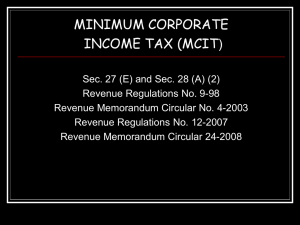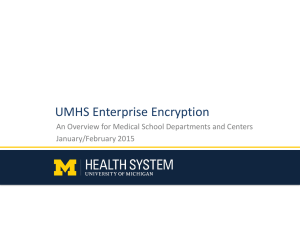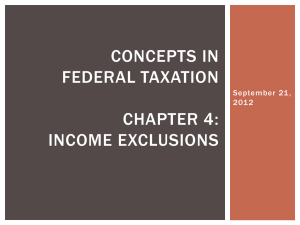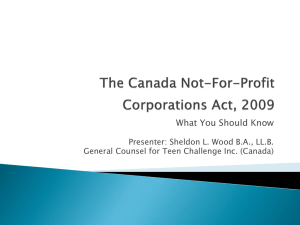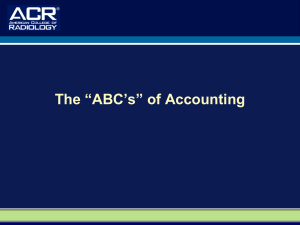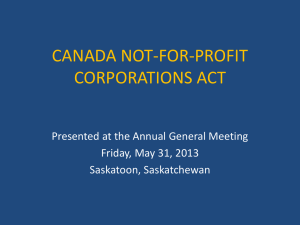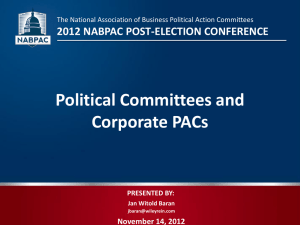INCOME TAX - Susan Dajao Tusoy
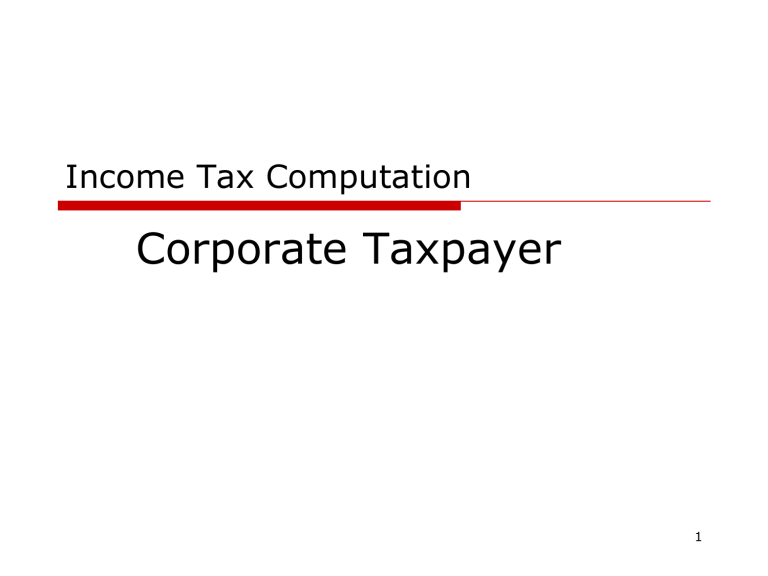
Income Tax Computation
Corporate Taxpayer
1
What is a corporation?
Corporation – is an artificial being created by law, having the rights of succession and the powers, attributes and properties authorized by law or incident to its existence.
For taxation purposes, corporation shall include –
Partnerships
Joint-stock companies
Joint accounts
Associations
Insurance companies
2
A corporation does not include –
• General Professional Partnership
• Joint venture or consortium formed for the purpose of undertaking construction projects or engaging in petroleum, coal, geothermal and other energy operations pursuant to an operating or consortium agreement under a service contract with the government
3
Classification of Corporation
Domestic corporation
Foreign corporation
Resident Foreign – engaged in trade or business within the Phil. Generally, it establishes branch or an office for the purpose of doing business or trade.
Non-Resident Foreign – not engaged in trade or business within the Philippines.
4
Evolution of Corporate Income Tax Rate
Tax Rate Effectivity Basis
34%
33%
32%
35%
30%
Jan 1, 1998
Jan 1, 1999
Jan 1, 2000
Nov 1, 2005
Jan 1, 2009
RA 8424
RA 8424
RA 8424
RA 9337
RA 9337
5
Taxability of Corporations (RA 9337)
Income In General
All income derived from sources within or outside the Phils.
All income derived from sources within the Phils.
Optional Corporate Tax
Rate
Minimum Corporate
Income Tax (MCIT)
Domestic Resident
Foreign
30%
(Net
Taxable
Income)
--
30%
(Net Taxable
Income)
Non-Res.
Foreign
--
30%
(Gross
Income)
15%
(Gross
Income)
2%
(Gross
Income)
15%
(Gross
Income)
2%
(Gross
Income)
---
--
6
Taxability of Corporations
Domestic corporations
In general
Taxable on all income
Derived from sources
Within and without the Phil.
Optional corporate tax rate
(based on gross income)
Minimum Corporate Income Tax
(MCIT)
30%
15%
2%
7
Taxability of Corporations
Domestic corporations
Proprietary educational institutions
& hospitals (non-profit)
GOCCs (except GSIS, SSS, PHIC and PCSO)
Improperly accumulated earnings
Passive income
Interest
Interest income from FCDU
7.5%
Royalties 20%
10%
30%
10%
20%
8
Taxability of Corporations
Domestic corporations
Capital gains from sale of shares of
Stocks not traded in the SE
Not over P100,000
- In excess of P100,000
Income from foreign currency loans
Granted by depository bank under FCDU
Intercorporate dividends
Capital gains from sale of land and building
5%
10%
10% exempt
6%
9
Taxability of Corporations
Resident Foreign corporations
In general
Taxable on all income derived from sources within the Phil.
Optional corporate tax rate
(based on gross income)
Minimum Corporate Income Tax
(MCIT)
30%
15%
2%
10
Taxability of Corporations
Resident Foreign corporations
Gross Philippine Billings
International air carrier
2.5%
International shipping
2.5%
Interest income on foreign currency
Loans granted by OBU
Branch profit remittance
Regional or area headquarters
Regional operating headquarters
10%
15% exempt
10%
11
Taxability of Corporations
Resident Foreign corporations
Passive income
Interest
Interest income from FCDU
7.5%
Royalties
Income from foreign currency loans
Granted by depository bank under FCDU
Capital gains from sale of shares of
Stocks not trade in the SE
Not over P100,000
In excess of P100,000
Intercorporate dividends
20%
20%
10%
5%
10% exempt
12
Taxability of Corporations
Non-resident Foreign corporations
In general
On gross income received from all sources within the Phils.
Cinematographic film owner, lessor, or distributor
Owner/lessor of vessels chartered by
Phil. Nationals
Owner/lessor of aircraft, machineries
& other equipment
30%
25%
4.5%
7.5%
13
Taxability of Corporations
Non-resident Foreign corporations
Interest on foreign loans
Intercorporate dividends
Capital gains from sale of shares of stocks not traded in the SE
Not over P100,000
In excess of P100,000
10%
20%
15%
5%
14
T
he
Normal Corporate Income Tax
BIR Form 1702 (General Format for Income tax computation on business income)
P xxx Sales/ Revenues/ Fees from within and without
Less: Sales returns, allow., and disc. (if any)
Cost of Sales
Gross Income from operation
Add: Non-operating and other income not
P xxx xxx xxx
P xxx
Gross Income
Less: Allowable itemized business deductions/ OSD
Net Taxable Income
Multiply by Normal Corporate Income Tax Rate
Normal Corporate Income Tax xxx xxx xxx
30% xxx
===
15
MINIMUM CORPORATE INCOME TAX
(MCIT)
RR No. 9-98, as amended by RR no. 12-07
16
Sec. 27(E) and 28 (A)(2) of the NIRC
Imposed on:
Domestic & Resident Foreign
2% on Gross Income if: - in the 4 th year of operation
- net loss/zero taxable income/
MCIT is greater than NCIT
17
Gross income
Include all items of gross income enumerated under Section
32(A) of the Tax Code, as amended, except income exempt from income tax and income subject to final. withholding tax.
For Sale of goods
Gross sales – (cost of goods sold + sales returns + discounts+ allowances)
“Gross sales”
Include only sales contributory to income taxable under Sec.
27(A) of the Code.
“Cost of goods sold”
Include all business expenses directly incurred to produce the merchandise to bring them to their present location and use.
18
For sale of services
Gross revenue – (cost of services/direct cost + sales returns + discounts + allowances)
“Gross Revenues”
Include income from sale of services, likewise, taxable under Sec. 27(A)
“Cost of services or Direct cost of Services”
Include all business expenses directly incurred or related to the gross revenue from rendition of services.
19
Illustration
Gross sales/ revenues
Less: Sales Ret., Disc & Allow.
Cost of Goods Sold/ services
1,000,000.00
25,000.00
500,000.00
Gross Income from operation
Add: Other Income not subject to
475,000.00
Final Tax or Capital Gains Tax 100,000.00
Total Gross Income subject to MCIT 575,000.00
========
20
Carry forward of Excess MCIT
•
Excess of MCIT over normal income tax shall be carried forward on an annual basis and credited against the normal income tax for the 3 immediately succeeding taxable years.
•
Excess MCIT can only be credited against the income tax due if the normal income tax is higher than the MCIT
21
Carry forward of Excess MCIT
• Excess MCIT which has not or cannot be so credited against the normal income tax due for the 3-year period shall lose its credibility.
• Excess MCIT cannot be claimed as a credit against the MCIT itself or against any other losses
22
Carry forward of Excess MCIT
• The final comparison between the normal income tax payable and the MCIT shall be made at the end of the taxable year.
• The payable or excess payment in the
Annual Income Tax Return shall be computed taking into consideration income tax payment made at the time of filing of quarterly income tax returns whether this be
MCIT or normal income tax
23
Rules on crediting of tax payments & taxes withheld
Annual Computation
NIT is higher than MCIT
Excess MCIT from prior year can be deducted from the NIT due
MCIT is higher than Normal
Income Tax
Excess MCIT from prior years cannot be deducted from the MCIT due
Excess withholding tax from prior year can be deducted from the NIT due
Excess withholding tax from prior year can be deducted from the MCIT due
24
Rules on crediting of tax payments & taxes withheld
Annual Computation
NIT is higher than MCIT
Quarterly taxes withheld can be credited from the
NIT due
MCIT is higher than Normal Income Tax
Quarterly taxes withheld can be credited from the MCIT due
Quarterly income tax payments whether Normal
Income Tax or MCIT can be deducted from the NIT due
Quarterly income tax payments whether MCIT or Normal Income
Tax can be deducted from the
MCIT due
Note: The final comparison between the NIT and MCIT shall be made at
25 the end of te taxable year
Rules on crediting of tax payments & taxes withheld
Annual Computation
NIT is higher than MCIT
Excess MCIT from prior year can be deducted from the quarterly NIT due
Excess withholding tax from prior year can be deducted from the quarterly NIT due
MCIT is higher than Normal Income Tax
MCIT from prior year cannot be
deducted from the quarterly MCIT due
Excess withholding tax from prior year can be deducted from the quarterly MCIT due
26
Rules on crediting of tax payments & taxes withheld
Annual Computation
NIT is higher than MCIT
MCIT is higher than Normal Income Tax
Quarterly taxes withheld can be credited from the quarterly NIT due
Quarterly taxes withheld can be credited from the quarterly MCIT due
Payment from previous quarters of the taxable year can be deducted from the cumulative tax due
Payment from previous quarters of the taxable year can be deducted from the cumulative tax due
Note : Quarterly comparison to determine whichever is higher between the NIT and MCIT shall be done on a cumulative basis
27
Suspension of MCIT
• Instances when MCIT may be suspended
Substantial losses on account of –
Prolonged labor dispute
Force majeure
Legitimate business reverses
• Who may suspend
Secretary of Finance upon recommendation of the CIR
28
Suspension of MCIT
• Required documentation
Submission of proof by the corporation
Duly verified by the CIR’s duly authorized representative
29
IMPROPERLY ACCUMULATED
EARNINGS TAX
(IAET)
RA 8424/ RR No. 2-2001/RMC 35-2011
30
CONCEPT OF IAET
• Taxpayer is a corporation
• Improper accumulation of taxable income beyond the reasonable needs of the business
• Non-distribution of earnings/profits to stockholders
• The purpose of accumulation is to avoid the payment of the income tax
• Imposition of tax equivalent to 10% of the improperly accumulated taxable income
• The tax imposed is in the nature of penalty to a corporation for improper accumulation of earnings beyond the reasonable needs of the business
31
EVIDENCE OF PURPOSE TO AVOID
THE TAX
• The corporation is a mere holding or investment company
• Earnings or profits are permitted to accumulate beyond the reasonable needs of the business
32
Reasonable vs. Unreasonable Accumulation
Reasonable Needs of Business:
Immediate needs of business, including reasonably anticipated needs (Immediacy
Test)
Unreasonable Accumulation
Not necessary for the purpose of the business considering all circumstances of the case
33
Reasonable Needs of Business
100% of the paid up capital or the amount contributed to the corporation representing the par value of the shares of stock, hence, any excess capital over & above the par shall be excluded
(RMC 35-2011) .
34
Reasonable Needs of Business
Earnings Reserved
for definite corporate expansion projects
for building, plant or equipment acquisition
for compliance with loan covenant or preexisting obligation established under a legitimate business agreement.
Required by law to be retained or with legal prohibition
In case of foreign corporation subsidiaries, intended for investments within the
Philippines
35
Unreasonable accumulation of Profits
Investment of substantial earnings and profits of the corporation in unrelated business or in stock or securities of unrelated business;
Investment in bonds and other long term securities; and
Accumulation of earnings in excess of
100% of paid-up capital or contribution representing the par value of the shares of stock.
36
Corporation Exempt from IAET
Banks and non-bank financial intermediaries
Insurance companies
Publicly held corporations
Taxable partnerships
GPP
Non-taxable joint ventures
Firms registered under RA 7916, 7227, and other special ecozones
37
IMPOSITION OF IAET
Tax rate 10%
Corporations liable
Deadline
Closely-held domestic corporations
15 th day after the end of he year following the close of the taxable year
38
Closely-held corporations:
are corporations at least 50% in value of the outstanding capital stock or at least 50% of the total combined voting power of all classes of stocks entitled to vote is owned directly or indirectly by or for not more than 20 individuals
39
TAX BASE OF IAET
(Improperly Accumulated Taxable Income)
P xxx Taxable income
Add:
(a) Income subject to final tax
(b) NOLCO
Pxxx xxx
(c) Income exempt from tax xxx
(d) Income excluded from gross income xxx
Total
Less: Income tax paid for the year xxx
Div. actually or const. paid/issued xxx
Total
Less : Amount that can be retained
IATI xxx
P xxx xxx xxx xxx
Pxxx
===
40
Payment of IAET
Dividend must be declared and paid not later than one year following the close of the taxable year
Otherwise, IAET should be paid within 15 days thereafter
Once the profit has been subjected to IAET, the same shall no longer be subjected to IAET in later years, even if not declared as dividend.
Profits subjected to IAET, when finally declared as dividends, shall be nevertheless be subject to 10% final withholding tax
41
Proprietary Educational
Institution
Any private school created and organized as domestic corporation and which is maintained and administered by private individuals or groups with an issued permit to operated from DECS, CHED or the TESDA, as the case may be, in accordance with existing laws and regulations.
Taxability
In general
If gross income from unrelated trade, business or other activity exceeds 50% of the total gross income
10%
30%
42
Non-Profit Hospital
A non-stock and non-profit domestic corporation organized and created to maintain and administer a hospital without a capital stock divided into shares, and no part of the income of which is distributable as dividends to its members, trustees or officers, but are used only for the furtherance of the said purpose. Hospital means an institution for the reception and care of sick, wounded, infirm or aged persons. It does not include hospitals for the care of animals.
Taxability
In general 10%
If gross income from unrelated trade, business or other activity exceeds 50% of the total gross income 30%
43
Exempted Corporations
(Sec. 30)
Labor, agricultural or horticultural organizations not organized principally for profit
Mutual savings bank without capital stock represented by shares and cooperative bank without capital stock organized and operated for mutual purposes and without profit
Beneficiary society, order or association, operating for the exclusive benefit of the members
Cemetery company owned and operated exclusively for the benefit of its members
Non-stock corporation or association organized and operated exclusively for religious, charitable, scientific, athletic, or cultural purposes, or for the rehabilitation of veterans.
44
Exempted Corporations
(Sec. 30)
Business league, chamber of commerce, or board of trade, not organized for profit
Civic league or organization not organized for profit but operated exclusively for the promotion of social welfare
Non-stock, non-profit educational institution
Government educational institution
Farmer’s or other mutual typhoon or fire insurance co., mutual ditch or irrigation co., mutual or cooperative telephone co. or like organization of local character
Farmers, fruit growers or like association organized and operated as sales agents of its members and turning back to them the proceeds of sales less the necessary expenses
Income from any of their properties or from any activity conducted for profit shall be subject to tax regardless of disposition.
45
Partnership
By the contract of partnership, two (2) or more persons bind themselves to contribute money, property or industry to a common fund with the intention of dividing the profits among themselves.
Types of Partnership
General partnership (Partnership)
General Professional partnership (GPP)
General Co-ownership
46
General Partnership
A partnership other than GPP
It is considered as a corporation for tax purposes
Partners are considered as stockholders thus, profits distributed are considered as dividends
Partners distributive share in the profits of the partnership is not subject to normal income tax
47
General Professional Partnership
Partnership formed by persons for the sole purpose of exercising their common profession, no part of the income of which is derived from engaging in any trade or business
Not considered as a corporation
GPP is not subject to income tax
Individual partners shall be liable to income tax on his share in the distributable net income of the GPP
48
General Co-Ownership
Activities of the coowners are limited to the preservation of the property and the collection of the income therefrom
Co-ownership is not subject to tax
Co-owner is taxed individually on his distributive share
Co-owners invest the income of the coownership in any income producing properties
Will constitute a partnership subject to tax as a corporation
49
Income Tax Forms and
Due Dates
50
Individual
Form
No.
Form Name Deadline for Filing
1701Q Quarterly Income
Tax Return
1701 Annual Income Tax
Return
1 st – April 15
2 nd – August 15
3 rd – November 15
Calendar – April 15
Fiscal – 15 th day of the 4 th month ff. the close of the year
No. of
Copies
3 copies
3 copies
Corporations
Form
No.
Form Name Deadline for Filing
1702 Annual Income Tax
Return
On or before April
15
(For Corporations,
Partnerships and
Other Nonindividual
Taxpayers)
On or before the
15 th day of the 4 month following the close of the fiscal year th
No. of
Copies
3 copies
52
Form
No.
Form Name Deadline for Filing No. of Copies
1702Q Quarterly Income Tax
Return
(For Corporations,
Partnerships and Other
Non-individual
Taxpayers)
60 days following the close of the first
3 taxable quarters
1704 Improperly
Accumulated Earnings
Tax Return
On or before the
15 th day of the following year following the taxable year
3 copies
3 copies
53
Attachments Required
Account Information Form (AIF) BIR Form 1702-
AIF and the Certificate of the Independent CPA
(The CPA Cert. is req’d. if the Gross sales, earnings, receipts exceed P150,000.00);
Certificate of income payments not subjected to withholding tax (BIR Form 2304), if applicable;
Certificate of Creditable withholding tax withheld at source (BIR Form 2307, if applicable);
54
Summary Alphalist of W/T (SAWT) per RR 2-2006;
Duly approved Tax Debit Memo, if applicable;
Proof of prior year’s excess credits, if applicable;
Proof of Foreign Tax credits, if applicable;
For amended return, proof of tax payment and the return previously filed;
For those availing of fiscal incentives, see RMC No.
21-2007
55
Deductions from the Income Tax Due
• Taxes withheld from current year’s income
• Tax credits for foreign taxes paid
• Tax credits (tax credit memo)
• Taxes paid in the first 3 quarters (NIT or MCIT)
• Excess tax payments in the preceding year
56
NOTE:
Installment Payments
• Applicable to individual taxpayer only and NOT TO CORPORATION
next
57
“ Knowing is not enough; we must apply.
Willing is not enough; we must do.
”
Johann Wolfgang von Goethe
58
